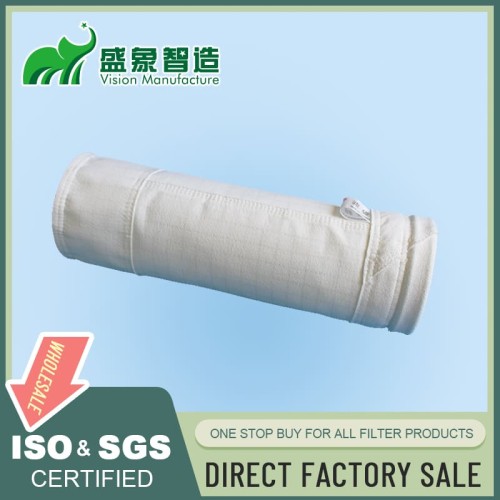
High Temperature Filter Bags Tackle Extreme Industrial Environments
I. Introduction
High-temperature filtration presents unique challenges in industrial settings, requiring specialized solutions to maintain air quality and protect equipment. This section introduces high-temperature filter bags, essential tools for handling extreme conditions, and discusses their importance in various industrial processes.
II. Materials Used in High Temperature Filter Bags
High-temperature filter bags are made from materials capable of withstanding extreme heat:
- Fiberglass: Offers excellent heat resistance up to 280°C and good chemical resistance.
- PTFE (Polytetrafluoroethylene): Known for its ability to resist high temperatures and aggressive chemicals.
- Aramid fibers (e.g., Nomex): Suitable for applications up to 204°C with excellent fire and heat resistance.
- PPS (Polyphenylene sulfide): Handles temperatures up to 190°C and resists both acids and alkalis.
- Specialty blends and composites: Developed for specific applications requiring unique properties.
III. Temperature Ranges and Applications
Different materials are suited to specific temperature ranges:
- 200°F to 400°F (93°C to 204°C) applications: Typically handled by aramid fibers and some specialty blends.
- 400°F to 600°F (204°C to 316°C) applications: Often require PPS or advanced fiberglass materials.
- 600°F to 800°F (316°C to 427°C) applications: Suitable for high-grade PTFE and certain fiberglass composites.
- Above 800°F (427°C) applications: Generally reserved for the highest quality PTFE and specialized high-temperature materials.
IV. Key Industries and Applications
High-temperature filter bags are crucial in industries where heat and emissions are prevalent:
- Cement and Lime Production: Critical for controlling emissions from kilns.
- Steel and Metal Processing: Used in furnaces and foundries to capture metal fumes.
- Power Generation Plants: Essential for coal-fired and waste-to-energy plants.
- Waste Incineration Facilities: Help manage emissions of toxic and corrosive gases.
- Chemical and Petrochemical Industries: Filter toxic chemicals under high temperatures.
- Glass Manufacturing: Used to control particulates during high-temperature glass melting.
V. Design Features
The design of high-temperature filter bags is tailored to meet the demands of extreme environments:
- Fiber Composition and Treatment: Specific fibers are chosen based on their temperature and chemical resistance.
- Weave Patterns and Densities: Designed to maximize filtration efficiency while maintaining airflow.
- Bag Shapes and Sizes: Customizable to fit various dust collection systems.
- Finishing Treatments and Coatings: Often include treatments to enhance dust release and temperature resistance.
VI. Performance Characteristics
These filter bags offer several performance advantages:
- Temperature Tolerance Range: Capable of operating under the specified temperature limits without degradation.
- Chemical Resistance Properties: Resist a wide range of industrial chemicals.
- Mechanical Strength and Durability: Maintain structural integrity under harsh conditions.
- Filtration Efficiency at High Temperatures: Effectively capture particulates even at elevated temperatures.
VII. Installation Considerations
Proper installation is crucial for maximizing the effectiveness of high-temperature filter bags:
- Proper Handling Techniques: Necessary to prevent damage during installation.
- Cage and Venturi System Compatibility: Ensures that bags are correctly supported and cleaned.
- Precoating Procedures: Often required to enhance initial filtration efficiency.
- Break-in Period Management: Important for stabilizing the filter's performance after installation.
VIII. Maintenance and Cleaning
Maintaining these filter bags involves:
- Inspection Schedules and Methods: Regular checks to ensure optimal performance.
- Cleaning Techniques: Includes pulse-jet, reverse air, and shaker methods tailored to the specific needs of high-temperature media.
- Replacement Indicators: Guidelines for when to replace bags to maintain efficiency.
- Proper Disposal Practices: Ensures environmentally responsible handling of used filters.
IX. Advantages and Limitations
- Benefits in High-Temperature Applications: Exceptional performance in extreme conditions.
- Extended Service Life in Extreme Conditions: Reduces the frequency of replacements.
- Improved Emissions Control: Helps meet stringent environmental regulations.
- Potential Drawbacks and Considerations: Includes handling sensitivity and cost implications.
X. Cost-Benefit Analysis
Evaluating the financial impact of high-temperature filter bags involves:
- Initial Investment vs. Long-Term Savings: Considering the upfront costs against the operational and maintenance savings.
- Energy Efficiency Improvements: Reductions in energy use due to improved airflow dynamics.
- Reduced Downtime and Replacement Frequency: Contributes to overall cost savings.
- Compliance Cost Reduction: Helps meet emission standards, potentially reducing regulatory costs.
XI. Environmental and Safety Considerations
- Emissions Control Capabilities: Effective in reducing particulate emissions.
- Workplace Safety Improvements: Enhances the air quality, contributing to a safer work environment.
- Disposal and Recycling Practices: Focuses on sustainable disposal and recycling of used filter materials.
- Regulatory Compliance Aspects: Meets stringent environmental and safety standards.
XII. Case Studies
Real-world applications demonstrate the effectiveness of high-temperature filter bags in various settings, showcasing their ability to solve complex filtration challenges and deliver significant improvements in performance and operational efficiency.
XIII. Technological Advancements
- Advanced Materials for Enhanced Performance: Innovations in fiber technology that improve durability and filtration efficiency.
- Smart Monitoring Systems Integration: Incorporation of sensors and monitoring systems for better management.
- Energy-efficient Designs: Enhancements that reduce the energy consumption of filtration systems.
- Integration with Plant-wide Automation: Streamlining operations across facilities for improved efficiency.
XIV. Conclusion
High-temperature filter bags are indispensable in industries that operate under extreme conditions. Their ability to perform reliably where other filters might fail makes them a critical component in ensuring operational continuity and compliance with environmental standards. As filtration technology evolves, these bags continue to play a crucial role in maintaining operational efficiency and protecting critical components from damage.
Leave a comment

